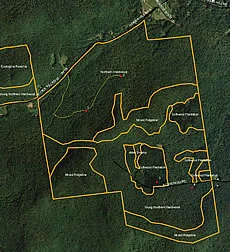by Bruce MacPherson
April 29, 2008. Bristol Pond. 6:45 P.M. 42 degrees F. Overcast. No wind. A single Sandhill Crane just flew into the marsh south of the boat access parking lot.
Those are my field notes from that April evening. But Sandhill Cranes in Vermont? You bet! For the past 3-4 years Sandhill Cranes have been sighted regularly in Vermont and in 2007 a pair of Sandhill Cranes successfully fledged a single chick. This information was dutifully recorded in the most recent Vermont Bird Breeding Atlas Survey. This year this pair of cranes returned to Vermont and produced two “colts”, as young cranes are called. Here is some background information about one of Vermont’s newest resident bird species.
All told there are 15 species of cranes worldwide, but only two species of cranes inhabit North America-Whooping Cranes, which are endangered, and Sandhill Cranes, which are thriving. In fact, there are over 600,000 Sandhill Cranes in North America. The breeding range of Sandhill Cranes extends from Siberia, through Alaska and western Canada to the Pacific Northwest and the northern Midwestern states. Vermont is at the far eastern edge of the Sandhill Crane’s range, but, who knows? Perhaps their range is expanding as their population grows.
The winter range of Sandhill Cranes includes south Texas, south-central New Mexico, Arizona, and northern Mexico. Cranes also gather in staging areas during their Spring and Fall migration. More on this later.
Cranes are ancient birds. In fact, a 10 million year old crane fossil was excavated from the tar pits found at the Ashfall Fossil beds in Nebraska and a Sandhill Crane fossil identical in every detail to modern Sandhill Cranes was carbon-dated at 2,000,000 years old. Apparently, Sandhill Cranes can adapt successfully to a changing environment.
Five Sandhill Crane subspecies have been described in the ornithological literature, two of which are migratory and three of which are not. Migratory Sandhill Cranes include the Greater and Lesser subspecies. Some authorities also include an intermediate-sized subspecies on this list-the Canadian subspecies. However, where cranes mingle on their wintering grounds, these intermediate-sized birds overlap at both ends of the growth spectrum with Greater and Lesser Sandhll Cranes and cannot be reliably distinguished from them by either morphological criteria or DNA analysis.
The non-migratory subspecies are found in Cuba, Florida, and Mississippi. The Sandhill Crane population in Florida appears to be stable, but both the Mississippi and Cuban subspecies are endangered.
Sandhill Cranes are majestic birds, somewhat resembling herons and egrets. Herons, egrets, and cranes are not closely related, though. Great Blue Herons and Great Egrets are assigned to the family Ardeidae, whereas cranes occupy the family Gruidae. The scientific name for Sandhill Cranes is Grus canadensis. Sandhill Cranes are 3-4 feet in length with a wing span approaching six feet. They have three long toes on their feet attached to long, featherless legs. Cranes also have a vestigial posterior toe. However, unlike herons and egrets, cranes are unable to grasp branches. Accordingly, cranes roost on the ground, rather than in trees or perches like herons and egrets. Also, cranes fly with their neck extended in contrast to herons and egrets which fly with their neck coiled.
Sandhill Crane plumage is gray overall, but often their feathers take on a rust color due to “painting” with iron-rich soil during preening. In addition to their long, dagger-shaped bill, adult Sandhill Cranes have a distinctive red crown, which becomes more prominent when they are excited, and a white face patch. In general, Sandhill Cranes are so distinctive that differentiating them from herons and egrets is not difficult.
And Sandhill Cranes dance! With enthusiasm! Why cranes dance is not fully understood, but this behavior probably serves as a courtship ritual during breeding season and a means of communication between cranes otherwise. Body posturing generally is a feature of crane behavior which may signify a warning to other cranes in the area that are vying for territory, a predator alert , or simply a sign from a leader saying “Let’s go.” Similarly, Sandhill Cranes utter a vast number of vocalizations to each other, including distinct contact, flight intention, location, and alarm calls.
Sandhill Cranes are omnivores, their diet consisting of grains, mice, snakes, frogs, eggs, and insects. However, on their staging grounds 80% of their diet consists of waste grain, especially corn. Managing the crane population on their wintering grounds and staging areas, where thousands of Sandhill Cranes gather, represents a formidable challenge, since a single Sandhill Crane consumes up to a half pound of grain per day. At the Rowe Audubon Sanctuary in Gibbon, Nebraska, where 500,000 Sandhill Cranes congregate for a month in March and April before leaving for their breeding grounds, cranes eat about 1600 tons of waste corn during their stay.
Sandhill Cranes become sexually mature at 2-6 years of age and typically hatch 1-2 eggs in breeding season. Nests typically are constructed in a marsh surrounded by water where cranes roost at night. This habitat provides protection from nosy (and noisy) predators, who might attack the nest. Since on average Sandhill Cranes live about 25 years, they may produce a large number of offspring during their lifespan. Cranes are monogamous more or less and the family unit stays together during migration. Accordingly, scanning large flocks of Sandhill Cranes when they are on their wintering grounds reveals small clusters of cranes mingling and flying together. These birds represent family units.
In November, 2007, my wife Pam and I attended the 20th annual “Festival of the Cranes” at Bosque del Apache NWR in San Antonio, New Mexico. This festival celebrates the return of over 5000 Sandhill Cranes to their wintering grounds. We attended a variety of workshops and field trips, many devoted to Sandhill Cranes as well as the large variety of waterfowl and raptors that inhabit the refuge. One of our instructors was Keanna Leonard, the education coordinator at Rowe Audubon Sanctuary in Nebraska, the staging area for over 500,000 Sandhill Cranes in March-April. Keanna graciously agreed to answer a few questions about Sandhill Cranes for this article. Thanks to Bill and Mae Mayville who generously provided photographs of the Bristol Pond Cranes.









